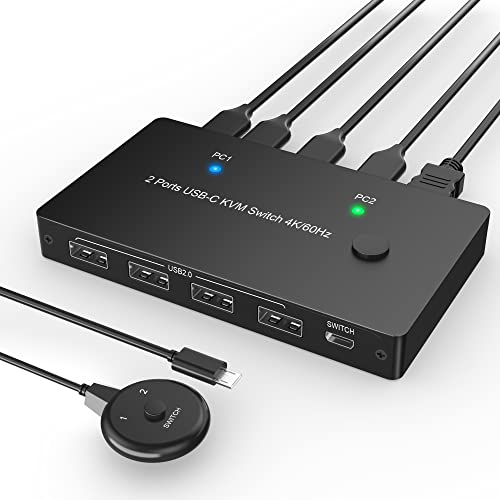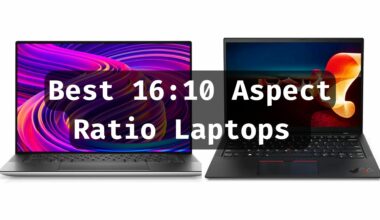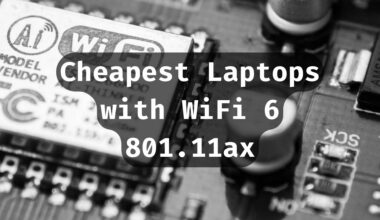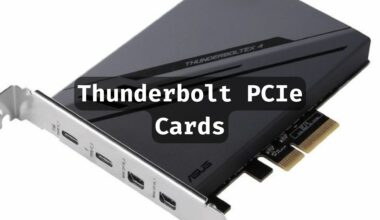Individually, you’ll find limitless information about KVM switches and Thunderbolt 4 technology. And if you look for Thunderbolt 4 KVM switches, you’ll even find a handful of devices that enable you to connect your Thunderbolt 4 computer. But are these KVM switches indeed Thunderbolt 4 devices? Or do manufacturers get away with cleverly worded product listings and marketing collaterals?
Table of Contents
- What is A True Thunderbolt 4 KVM Switch?
- Comparison of the Best True Thunderbolt 4 and Thunderbolt 4 Compatible KVM Switches
- 1. SABRENT Thunderbolt 4 KVM Switch – Our Choice
- 2. VisionTek VT2900 – Gigabit Ethernet
- 3. Cable Matters Dual 4K 60Hz USB-C KVM Switch – Wireless Remote
- 4. YIWENTEC USB-C 8K KVM Switch – Cheapest
- 5. Rytaki Pro USB-C KVM Switch – Value for Money
- Best True Thunderbolt 4 and Thunderbolt 4 Compatible KVM Switches – Frequently Asked Questions (FAQs)
What is A True Thunderbolt 4 KVM Switch?
Before proceeding any further, you must know precisely what True Thunderbolt 4 devices are.
Essential of Thunderbolt 4
In a nutshell, Thunderbolt 4 is a communication protocol to connect peripheral devices. Like USB, Thunderbolt 4 most significant feature is that it enables data, power, and video signal transmission on a single cable. But not all devices featuring these functionalities become certified Thunderbolt 4 devices.
Intel, the creator of Thunderbolt 4, lists a set of minimum specifications for a device to be a certified Thunderbolt 4 device (read True Thunderbolt 4 devices). Certified Thunderbolt 4 devices will support the following.
- A display with a Single 8K@60Hz or Dual 4K@60Hz resolution.
- A Power Delivery of a minimum of 15W and a maximum of 100W.
- Data Transfer speeds of 40Gbps.
- Support for Daisy Chaining multiple devices.
- Passive Cables with a 2-meters length.
- VT-d-based Direct Memory Access protection.
For the sake of simplicity, instead of thinking of Thunderbolt 4 as a technology, consider it a certification that Intel provides to any device that adopts this technology and fulfills the criteria mentioned above.
KVM Switches And True Thunderbolt 4 KVM Switches
Now that you understand Thunderbolt 4, you’ll clearly understand true Thunderbolt 4 KVM switches.

Image Credit: Melanie Pinola Via NYTIMES.com
The truth is that most KVM switches use USB-C to offer Thunderbolt-like features, allowing you to attach your Thunderbolt computers when you need to work on multiple devices. But that doesn’t make them true Thunderbolt 4 KVM switches. Many such switches natively use USB4 or Thunderbolt 3 internally, and because USB4 and Thunderbolt use a USB-C connector, the technology used in most KVM switches remains obscured from the end user.
For instance, consider the IOGEAR 2-Port KVM switch; it uses USB natively but has USB-C connectors. You can connect your Thunderbolt 4 computer and get a Power Delivery of 75W, 4K@60Hz video, and data transfer. But it is not a Thunderbolt 4 KVM switch, and to be fair to IOGEAR, they don’t call it that either. The absence of 8K video support and data speeds of 5Gbps indicates that it’s not a Thunderbolt 4-rated device.
Interestingly, USB-C KVM switches are compatible with Thunderbolt 4 computers due to Thunderbolt’s backward compatibility with USB. As a result, while you get all the basic functionalities, you miss out on exclusive features that Thunderbolt offers.
It’s 2023, and we finally have the first True Thunderbolt 4 KVM switch. While the majority of KVM switches continue to be “Thunderbolt compatible,” you have a True Thunderbolt 4 KVM switch to connect your Thunderbolt 4 computers and ease your multitasking needs while ensuring you have the best that technology has to offer.
Comparison of the Best True Thunderbolt 4 and Thunderbolt 4 Compatible KVM Switches
| Image | Product | Details | Check Price |
|---|---|---|---|
 | SABRENT Thunderbolt 4 KVM Switch | Type: True Thunderbolt 4 No. of Computers: 2 Video: 8K@60Hz Video Interface: Thunderbolt 4 Total USB-A Ports: 4 Audio Jack: No USB-C Power Delivery: 60W Remote: Wired Release Date: Jun-2023 | Buy on Amazon |
 | VisionTek VT2900 | Type: Thunderbolt 4 Compatible No. of Computers: 2 Video: 4K@60Hz Video Interface: HDMI and DisplayPort Total USB-A Ports: 3 Audio Jack: Yes USB-C Power Delivery: 100W Remote: No Release Date: Dec-2022 | Buy on Amazon |
 | Cable Matters Dual 4K 60Hz USB-C KVM Switch | Type: Thunderbolt 4 Compatible No. of Computers: 2 Video: 8K@60Hz Video Interface: HDMI and DisplayPort Total USB-A Ports: 4 Audio Jack: No USB-C Power Delivery: No Remote: Wireless Release Date: Oct-2022 | Buy on Amazon |
 | YIWENTEC USB-C 8K KVM Switch | Type: Thunderbolt 4 Compatible No. of Computers: 2 Video: 8K@60Hz Video Interface: DisplayPort Total USB-A Ports: 4 Audio Jack: No USB-C Power Delivery: No Remote: No Release Date: Apr-2022 | Buy on Amazon |
 | Rytaki Pro USB-C KVM Switch | Type: Thunderbolt 4 Compatible No. of Computers: 2 Video: 4K@60Hz Video Interface: HDMI Total USB-A Ports: 4 Audio Jack: No USB-C Power Delivery: 100W Remote: Wired Release Date: Feb-2023 | Buy on Amazon |
 | TESmart USB-C KVM Switch 3 in 1 Out | Type: Thunderbolt 4 Compatible No. of Computers: 3 Video: 4K@60Hz Video Interface: HDMI Total USB-A Ports: 2 Audio Jack: Yes USB-C Power Delivery: 65W Remote: Wireless Release Date: Jan-2021 | Buy on Amazon |
 | StarTech.com 2 Port USB-C KVM Switch | Type: Thunderbolt 4 Compatible No. of Computers: 2 Video: 4K@60Hz Video Interface: HDMI Total USB-A Ports: 2 Audio Jack: No USB-C Power Delivery: No Remote: No Release Date: Sep-2020 | Buy on Amazon |
 | IOGEAR 2-Port USB-C KVM | Type: Thunderbolt 4 Compatible No. of Computers: 2 Video: 4K@30Hz Video Interface: HDMI Total USB-A Ports: 3 Audio Jack: No USB-C Power Delivery: 85W Remote: Wired Release Date: Aug-2019 | Buy on Amazon |
1. SABRENT Thunderbolt 4 KVM Switch – Our Choice
Presently, the Sabrent Thunderbolt 4 KVM switch is the only one that natively uses Thunderbolt 4, making it the natural (albeit the only) pick among rated KVM switches.
This switch lets you connect two Thunderbolt 4 computers for inputs and provide three output ports of the same standard. So, in addition to a Thunderbolt 4 monitor, you can connect and share other devices, including Thunderbolt SSD.
The native Thunderbolt 4 technology offers video outputs up to 8K@60Hz while using a single screen. It is one of the few KVM switches with 8K video support and the only one that uses Thunderbolt 4 connectivity to offer the same. You also have the option to connect two screens with video resolutions of 4K@60Hz, ideal for enhancing productivity and simplifying your multitasking needs.
Expectedly, the switch has USB ports to connect your keyboard and mouse, but it has two more USB ports for connecting any legacy peripheral devices. These USB-A ports adhere to the USB 3.2 Gen 2 standards that support data transfer speed up to 10Gbps and BC1.2 charging.
The device requires external power and includes a 24V/5A power adapter that generates enough power to ensure that the Thunderbolt 4 ports offer 60W Power Deliver. For further convenience, Sabrent includes a wired remote, which is especially handy when you want to unclutter your workstation.
- It supports 8K@60Hz video, which is ideal for highly intricate graphics work.
- Plenty of USB-A ports to connect legacy devices.
- Plenty of Thunderbolt 4 ports let you connect Thunderbolt 4 devices, including SSD drives.
- It includes a remote, which helps to declutter your workstation.
- Universal compatibility across platforms and various Operating Systems.
- Expensive
- The 60W Power Delivery is less for most high-powered laptops.
2. VisionTek VT2900 – Gigabit Ethernet
Standard KVM switches include enough USB ports to connect your keyboard, mouse, and legacy devices. The VisionTek VT2900 goes further by including a Gigabit Ethernet port you can share between the two computers you hook up to the switch.
The VT2900 is a Thunderbolt 4 compatible KVM switch that natively uses USB. Even though VisionTek uses USB 3.0, it offers DisplayPort Alt Mode to receive video signals on the USB-C connectors for host computers. Unfortunately, the use of USB 3.0 limits data rates to 5Gbps.
Nevertheless, this KVM switch from VisionTek supports dual display setups via DisplayPort and HDMI ports. You can choose between a single monitor setup with 4K@60Hz video or a dual-display setup with 4K@30Hz resolution.
Apart from the Gigabit Ethernet port, you get an audio jack and three USB-A 3.0 ports to connect peripheral devices. The switch is powered externally using the included power adapter, and the device supports 100W Power Delivery to one computer.
VisionTek does not include a remote with the switch, so you must use the power button, which doubles up as a switch, to alternate between host computers.
- The Gigabit Ethernet Port allows you to share one connection with two hosts.
- The 100W Power Delivery will charge most laptops.
- It supports a dual-display setup, making it convenient to multitask.
- It’s compatible with leading Operating Systems.
- The USB-C and USB-A ports on the front panel support Fast Charging for mobile devices.
- Data transfer speeds are limited to 5Gbps due to USB 3.0.
- No remote
3. Cable Matters Dual 4K 60Hz USB-C KVM Switch – Wireless Remote
Although the use of USB-C has reduced the cables required to hook up a KVM switch, an optimized workstation is one that is uncluttered. This KVM switch from Cable Matters has a wireless remote that lets you place the switch away from your work area to avoid using its buttons to switch hosts.
While the device is Thunderbolt-compatible, it lacks Power Delivery. It’s equipped to handle two hosts using the USB-C port and has four USB-A ports to connect peripheral devices. The switch uses USB 3.0, so the maximum data transfer speed is capped at 5Gbps.
The device has DisplayPort and HDMI ports, allowing you to connect dual displays. DisplayPort allows a resolution of up to 8K@30Hz, and you can use the HDMI port if you want a dual-monitor setup that’ll support 4K@60Hz.
Its design is pretty standard. The front panel has USB-A ports, while the rear panel has USB-C connectors for the two hosts and the video interface ports. There is a power switch on the side panel and two buttons on the top panel that allow you to select the host.
- The wireless remote helps minimize wires.
- The device supports high-resolution displays up to 8K resolution.
- The compact size occupies minimal space at your workstation.
- Multitasking is easy with support for dual-monitor setups.
- Affordable
- No Power Delivery to charge host computers.
- Data transfer speeds are limited to 5Gbps due to USB 3.0.
4. YIWENTEC USB-C 8K KVM Switch – Cheapest
KVM switches are expensive, and USB-C/Thunderbolt KVM switches are more expensive than conventional devices. The Yiwentec USB-C 8K KVM switch doesn’t offer all the frills you get with pricier devices. Still, the significant price difference is a considerable advantage, especially while using two desktop computers.
The switch uses USB 2.0 and offers USB-C connections for two hosts. There are two USB-A ports for connecting the keyboard and mouse and one additional port for connecting another peripheral device. The USB-C ports don’t support Power Delivery, so you must ensure that your laptops are charged externally. Nevertheless, these ports support DisplayPort Alt Mode for receiving video signals from the host computer.
Unlike most other KVM switches that have a DisplayPort and an HDMI port, Yiwentec’s KVM switch offers just a DisplayPort v.1.4. So while you won’t get a dual-monitor setup, the switch supports a video resolution of 8K@60Hz, ideal for graphics work.
Despite its limited form, the device is perfect for network administrators who configure several servers during a typical workday. It offers all the essential features of a KVM switch, enabling you to multitask using two computers. It’s perfect for large offices where several such switches are used. It’s also great if you are looking for an inexpensive device and are willing to forego a few creature comforts like a remote or Power Delivery.
- Price
- The device supports high-resolution displays up to 8K resolution.
- The aluminum casing makes the device durable.
- The compact design occupies minimal space at your workstation.
- The 480Mbps data transfer speed is too low.
- No Power Delivery for charging laptops while you work.
5. Rytaki Pro USB-C KVM Switch – Value for Money
While the Yiwentec KVM switch is the cheapest, the Rytaki Pro offers phenomenal value for money. Priced just a higher than the Yiwentec KVM switch, it offers 100W Power Delivery and a wired remote, making it worth the price difference.
The Rytaki Pro is also a Thunderbolt-compatible device that uses USB 2.0 natively, so it has several limitations. But this comes as no surprise, especially considering the price of the Rytaki Pro. The device offers an HDMI interface for video and supports resolutions up to 4K@60Hz.
The switch features four USB-A ports connecting all your peripheral devices and four USB-C ports. Two USB-C ports are for powering the device and support power passthrough to facilitate Power Deliver on the USB-C host connections.
It’s a plug-and-play device compatible with all platforms and Operating systems. It is compact in size, making it super portable and ideal across any use case, be it gaming, productivity, and whatnot.
Like the Yiwentec KVM switch, it offers all the essential features of a KVM switch, but the data transfer speeds are limited to 480Mbps due to the native use of USB 2.0. Considering the price and the fact that it has all essential functionality along with a few frills, it offers tremendous value for money.
- The 100W Power Delivery is enough to charge most power-hungry laptops.
- The wired remote makes it convenient to switch between host computers.
- The compact design occupies minimal space at your workstation.
- Excellent value for money.
- It has plenty of USB-A ports to connect all your peripheral devices.
- Does not support 8K video.
Click here to read our review of the remaining KVM Switches.
Best True Thunderbolt 4 and Thunderbolt 4 Compatible KVM Switches – Frequently Asked Questions (FAQs)
Can I Use A Thunderbolt 4 KVM Switch with non-Thunderbolt 4 Devices?
Thunderbolt 4 is entirely backward compatible with USB. So while you can use any USB peripheral with a Thunderbolt 4 KVM switch, the data transfer speeds and other specifications of the USB device will be applicable, not those of Thunderbolt 4.
What is the Maximum Video Resolution Supported By A True Thunderbolt 4 KVM Switch?
To be a certified Thunderbolt 4 device, the KVM switch will support 8K video at a 60Hz refresh rate. Additionally, configurations can include a single 5K display running at 60Hz, and two 4K displays at 60Hz.
Do True Thunderbolt 4 KVM Switches Need External Power?
Since Thunderbolt 4 requires devices to support a minimum Power Delivery of 15W and a maximum of 100W, a Thunderbolt 4 KVM switch must be able to provide that. Thus, Thunderbolt 4 KVM switches draw power from a power adapter that the manufacturer usually includes to fulfill this requirement.
Can I Connect Multiple Monitors With A Thunderbolt 4 KVM Switch?
Yes, you can, as long as the KVM switch has enough Thunderbolt 4 ports to accommodate additional monitors. If not, you can daisy-chain a Thunderbolt 4 dock or hub to attach monitors.





